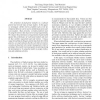Free Online Productivity Tools
i2Speak
i2Symbol
i2OCR
iTex2Img
iWeb2Print
iWeb2Shot
i2Type
iPdf2Split
iPdf2Merge
i2Bopomofo
i2Arabic
i2Style
i2Image
i2PDF
iLatex2Rtf
Sci2ools
88
Voted
ISSRE
2007
IEEE
2007
IEEE
Fault Prediction using Early Lifecycle Data
The prediction of fault-prone modules in a software project has been the topic of many studies. In this paper, we investigate whether metrics available early in the development lifecycle can be used to identify fault-prone software modules. More precisely, we build predictive models using the metrics that characterize textual requirements. We compare the performance of requirements-based models against the performance of code-based models and models that combine requirement and code metrics. Using a range of modeling techniques and the data from three NASA projects, our study indicates that the early lifecycle metrics can play an important role in project management, either by pointing to the need for increased quality monitoring during the development or by using the models to assign verification and validation activities.
Early Lifecycle Metrics | Fault-prone Software Modules | ISSRE 2007 | Predictive Models | Software Engineering |
Related Content
| Added | 26 Oct 2010 |
| Updated | 26 Oct 2010 |
| Type | Conference |
| Year | 2007 |
| Where | ISSRE |
| Authors | Yue Jiang, Bojan Cukic, Tim Menzies |
Comments (0)

